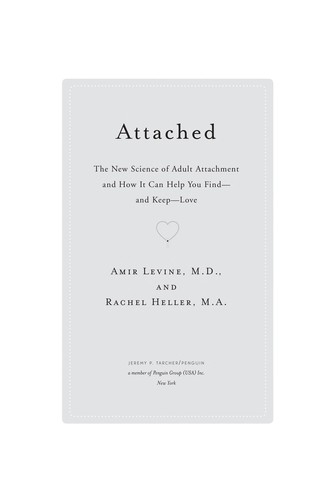

The whole book is really filtered through an anxious lens. The glorification of anxious types only increased from there. I knew something was up when the chapter dedicated to explaining anxious attachment was twice as long as the chapter dedicated to avoidant attachment. I'm convinced that all the 5 star reviews must be from anxiously attached people because this book offers nothing for anyone else lol. By pretending that you don't care about being in a serious relationship, you are just attracting the wrong people for you (avoidants, if you are anxious). But, as the authors point out, it would make no sense, especially if you are anxiously attached. This seems to be the prevailing wisdom of most dating books out there. Or that a woman should play hard to get and make a man "chase" her. One of the biggest things I liked about this book is that the authors didn't suggest that we should all go around acting uninterested and like we don't want serious relationships, when we do.

The book provides a lot of examples and checklists and inventories so that you can figure out what's going on in your relationship, how you might be exacerbating the problems, and give suggestions about how you could respond instead. I liked this book because I felt like it really helped me understand why a lot of the relationships I have stop working the way I want them to. Rather, they help you understand yourself and guide you in the direction you would like to go. They don't make you feel any shame for the category you fall into. According to the authors, 50% of the population is securely attached, 25% is anxious, and 25% avoidant. There are three types of attachment: secure, anxious, and avoidant. The author describes how attachment theory can be applied to romantic relationships. This book is better than most relationship books I have read. I don't want people to know that I spend time thinking about my relationship status. Not because it wasn't good, but because I have this thing about posting relationship-y self-help books on here. Acco I'm a little embarrassed to admit that I read this. I'm a little embarrassed to admit that I read this. An insightful look at the science behind love, Attached offers readers a road map for building stronger, more fulfilling connections.more

#Amir levine attached pdf how to
It also offers readers a wealth of advice on how to navigate their relationships more wisely given their attachment style and that of their partner. * SECURE people feel comfortable with intimacy and are usually warm and loving.Īttached guides readers in determining what attachment style they and their mate (or potential mates) follow. * AVOIDANT people equate intimacy with a loss of independence and constantly try to minimize closeness. * ANXIOUS people are often preoccupied with their relationships and tend to worry about their partner's ability to love them back. According to attachment theory, every person behaves in relationships in one of three distinct ways: In Attached, Levine and Heller trace how these evolutionary influences continue to shape who we are in our relationships today. Also central to attachment theory is the discovery that our need to be in a close relationship with one or more individuals is embedded in our genes. Attachment theory forms the basis for many bestselling books on the parent/child relationship, but there has yet to be an accessible guide to what this fascinating science has to tell us about adult romantic relationships-until now.Īttachment theory owes its inception to British psychologist and psychoanalyst John Bowlby, who in the 1950s examined the tremendous impact that our early relationships with our parents or caregivers has on the people we become. Heller reveal how an understanding of attachment theory-the most advanced relationship science in existence today-can help us find and sustain love. In this groundbreaking book, psychiatrist and neuroscientist Amir Levine and psychologist Rachel S. Attachment theory forms the basis for many bestselling books on the parent/child relationship, Is there a science to love? Is there a science to love? In this groundbreaking book, psychiatrist and neuroscientist Amir Levine and psychologist Rachel S.


 0 kommentar(er)
0 kommentar(er)
